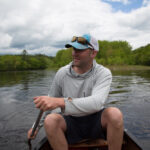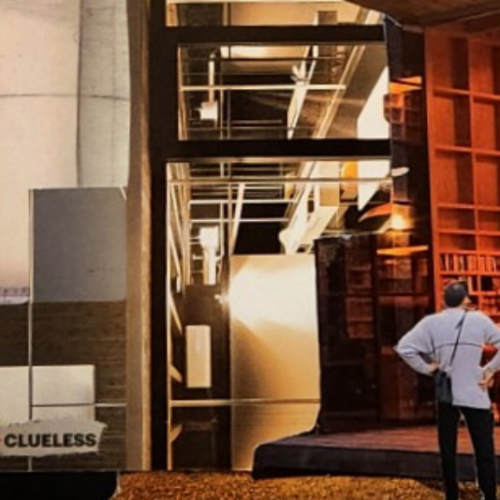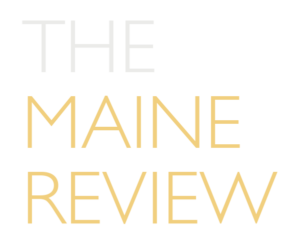November evenings, I waited at the window for my father to return from the woods. When I heard his truck rumbling up the hill, long after dark, I held the curtains open. He always backed into our semi-circle driveway, and usually the bed of his truck was empty. But some nights, gnarled antlers reached up from the tailgate—antlers washed in the red glow of brake lights. How quickly I rushed out to greet him.
When I am old enough—ten, according to my father—we practice shooting in a neighbor’s cleared cornfield. I drop the crosshairs of my Remington .243 over the target, but fire too quickly. I have trouble holding the gun steady. I eject a shell, chamber another, and fire. I hit the target high. My shoulder aches from the rifle’s kick. “Remember,” my father says from behind me, “take a breath, and squeeze.”
The doe chews buds beneath our two-man tree stand. Through my scope, I watch its long, black eyelashes. My father nudges me after the doe wanders off: Beautiful, wasn’t she? he whispers. He doesn’t ask why I didn’t shoot. A few seasons later, hunting alone: a small spike-horn and the coyote trailing it that I fire on but miss. A spindly-legged crotch-horn—gangly as a teenager—munches apples and paws leaves. Let it grow, I think. A doe startles herself when she farts; I hold my laughter so as not to frighten her even more. Years without a filled tag pile like cordwood. I wonder if I house the mechanism—whatever it is—that real hunters have, the thing that allows them to kill.
My mother’s encouragement—non-hunter, Brooklyn native: “It’ll happen when it happens!”
My father’s gentle skepticism: “You don’t have to shoot one, you know…”
“I want my first to be a good buck,” I tell him.
*
At the sound of my doe bleat, the buck is curious. Black hooves punch cloven tracks in crusty snow. From its bed near the cornfield—the same field where I practiced shooting twenty-five years ago—the buck walks steadily toward a small opening. My pulse thumps in my ears. When the buck steps broadside into my shooting lane, its antlers appear white against green cedar boughs.
I lower the crosshairs behind its front shoulder, breathe out, finger the trigger, and squeeze. Smoke from the muzzleloader clouds my view.
The buck bounds off. I have no idea if I’ve hit it. My father, in his early seventies now, an ear-shot away in the same woods, texts: “That you? Stay put, don’t chase. Wait 45 min.” He taught me as a boy that wounded bucks run for miles when pursued quickly. “Pure adrenaline,” he said. “You have to give them room to die.”
I replay the shot in my head. I check my cell phone. Fidget with hand-warmers. Scrunch my frozen toes. Shot too quicky; too high; too far back. My father’s passion, not mine. Wounded it, ruined it. Never going to happen. Not cut out for this.
Forty-five minutes later, I walk to the spot where the buck had stood. I find no blood, no hair. Nausea sweeps through my gut.
I follow tracks another twenty yards. The buck has followed a well-worn trail—it’s difficult to tell one hoof print from another. Ten feet farther, I find a tiny fleck of blood on glinted snow. Then a smattering, then splatter on a downed hemlock the buck leaped.
Where the buck crossed a snowmobile trail, it’s as if a painter dipped her brush then flicked a dotted line—red trail crossing white trail. Crushed raspberry red, red like hope.
Beyond the snowmobile trail, at a gap in the trees, I spot antlers in the snow, then the buck’s crumpled body. It can’t be, but it is. I might feel relief, or some kind of accomplishment, if not for the sensation that I’m in a waking dream.
I leave the buck to find my father; I want him to find it, too. “I found blood,” I say when I meet him near the field, “Can you help me with the tracking?” I try to keep a straight face, the face of a man that was once a boy waiting for his father to come home from these same woods.
I lead him to the blood trail. My father follows it, limping on his bad knee until I can’t wait any longer. “Dad, look—” I nod toward the clearing. He spots the buck—rediscovers it—lying dead amongst Douglas fir. His hearing aids chirp when he hugs me. “I can’t believe it,” he says, almost yelling, “I didn’t think I’d see the day.”
The knife’s sharp point makes my first incision near the buck’s anus. I remove its rectum, its testicles. I cut and peel, cut and peel, then break through. In my haste, an errant knife prick sends shit flying in my beard. Expelled gas, hot blood. Slimy fascia and a sucking sound when I reach in and remove vital organs. My hands blood-warm and slick, I think of birth. Quills of buck hair stick to my red forearms. Eyeing the steaming gut pile, my father says, “Coyotes will sure eat well tonight.”
The buck drags easily over the hard-packed snow. In the field, we hoist it, antlers first, into the bed of my father’s truck. We shovel the truck free, and I hop in back with the buck, holding its antlers to stabilize against the field’s dips and bumps.
I imagine the buck’s origin as it lies limp in the truck bed: its mother watching over her fawn, spotted and scentless, nursing him among the tall grasses and corn stalks.
Beech nuts, acorns, wildflowers, tree buds, blackberries, apples, clover, mushrooms, bark, hemlock needles. Easy spring meals and brutal winter ones, pawing at ice to find any kind of sustenance.
As we near the road, I think of shared hunger, my father’s and mine—a hunger that escapes or maybe lives beyond words. Motivation to rise early and walk beneath a blanket of stars. These same mornings, our grandfathers and theirs woke early, hot breath rising like apparitions in the dark.
The eight-point buck hangs to drain at the cold storage room—my buck, which is a strange and uncomfortable attribution. I reach in its hollowed torso and remove the loin. I cut gently, then pull. I break peritoneum with fingertips, pull again; violet, striated flesh flecked with blood.
My father’s cast iron skillet is black as a deer’s hoof. The loin rests on the counter as if waiting patiently—trimmed, rinsed, sea salt and pepper coated.
Olive oil snaps in the pan. I lower the loin gently onto the steaming cast iron. The meat sizzles. I am careful not to overcook it; two minutes per side, then we’re ready to eat.
We sit down to lunch at my father’s table. On the platter between us, blood pools from the knife’s clean cut. I offer the first piece to my father. He chews the morsel, closes his eyes, nods. I take a piece. We don’t speak. We give each other room to eat. I try to eat slowly—to savor this meal that has taken so long to arrive—but I’m hungry, and the venison is perfectly cooked.

Ryan Brod
Ryan Brod's work appears in River Teeth, Gray's Sporting Journal, The FlyFish Journal, regularly in The Drake magazine, where he's a senior contributor, and online at The Learned Pig, among other places. A fly-fishing guide and filmmaker, Ryan graduated from USM's Stonecoast MFA program. He teaches first-year writing and creative nonfiction at The University of New England, in Biddeford, Maine.



